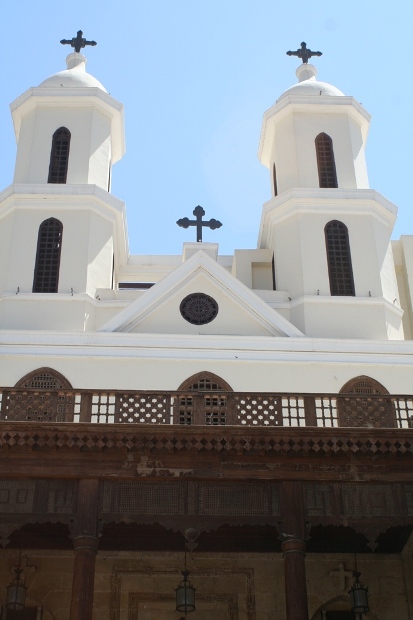|
Fast Facts & Historical Overview
at a glance:
Copts represent 10% of the Egyptian population, which account to
approximately 6 million. The minority is a strong and united economic
force, driving the Egyptian economy to steadily flourish (Naguib
Sawiras and Samir Sawiras as marker Christian businessmen
and investors). It has also provided a well- educated elite to fill
important posts in Egypt (such as Botros Botros Ghali Former
UN Secretary General). The word “Copt” (“Qibti” in Arabic) is derived
from the Greek word “Aegyptios, meaning Egyptian; which became synonymous
with Egyptian Orthodox Christianity. Many believe in the
evident parallels between Coptic Christianity and ancient Egyptian
religion, which made it easy for Egypt to smoothly converse to Christianity.
For example, the “ankh” was ancient Egyptians’ symbol of eternal
life, which is very similar in shape to the Coptic Cross.
 There
are also sculptures dating back to 1400 of Isis carrying her infant
Horus in a very similar manner to Virgin Mary embracing her Infant
Christ. The year 27 BC marked a great change in Egyptian history,
as Egypt became under the Roman rule. Egyptians were profoundly
restricted in autonomy, and hence, faced a great sense of spiritual
void. The overall religious situation in Egypt drove Saint Mark
the Evangelist- one of the 12 Apostles- to introduce Christianity
to Egyptians around the first AD, for
Alexandria
to become one of the first Patriarchs. However, Christianity represented
a threat to the Roman Empire because new Christian believers no
longer regarded the Emperor as a deity. Consequently, brutal events
of massacres, and torture of Christians followed to reach its maximum
during Emperor Dioclentian’s ruling. So, Christians decided to adopt
the Coptic calendar known as “the martyr’s calendar” to commemorate
the mentioned period of torture, also marking the beginning of Christianity
in Egypt. In 324 AD, Constantine issued a decree ending the prosecution
of Christians and calling for tolerance. By the 4th century Christianity
became the official religion in Egypt, with much of the scripts
and literature written in Coptic Language. However, in AD 451 Egyptian
Christians decided to split from the Orthodox Church after it had
proclaimed the dual human and divine nature of Christ (believing
only in Christ’s divinity). The latter resulted in creating a united,
and nationalistic Christian community, increasingly writing in the
Coptic Language to create spectacular art. Moreover, it was Egypt
that gave birth to the monastic tradition with Saint Anthony’s Monastery,
near Hurghada marking
its beginning to spread to the entire world later on. Internally,
the tradition spread for
Saint Catherine in Sinai
and Wadi Natrun near
Alexandria
to become marker tourist monasteries. There
are also sculptures dating back to 1400 of Isis carrying her infant
Horus in a very similar manner to Virgin Mary embracing her Infant
Christ. The year 27 BC marked a great change in Egyptian history,
as Egypt became under the Roman rule. Egyptians were profoundly
restricted in autonomy, and hence, faced a great sense of spiritual
void. The overall religious situation in Egypt drove Saint Mark
the Evangelist- one of the 12 Apostles- to introduce Christianity
to Egyptians around the first AD, for
Alexandria
to become one of the first Patriarchs. However, Christianity represented
a threat to the Roman Empire because new Christian believers no
longer regarded the Emperor as a deity. Consequently, brutal events
of massacres, and torture of Christians followed to reach its maximum
during Emperor Dioclentian’s ruling. So, Christians decided to adopt
the Coptic calendar known as “the martyr’s calendar” to commemorate
the mentioned period of torture, also marking the beginning of Christianity
in Egypt. In 324 AD, Constantine issued a decree ending the prosecution
of Christians and calling for tolerance. By the 4th century Christianity
became the official religion in Egypt, with much of the scripts
and literature written in Coptic Language. However, in AD 451 Egyptian
Christians decided to split from the Orthodox Church after it had
proclaimed the dual human and divine nature of Christ (believing
only in Christ’s divinity). The latter resulted in creating a united,
and nationalistic Christian community, increasingly writing in the
Coptic Language to create spectacular art. Moreover, it was Egypt
that gave birth to the monastic tradition with Saint Anthony’s Monastery,
near Hurghada marking
its beginning to spread to the entire world later on. Internally,
the tradition spread for
Saint Catherine in Sinai
and Wadi Natrun near
Alexandria
to become marker tourist monasteries.
In 641 AD, Arab general "Amr Ibn Al-Aas" and his forces entered
Egypt to create a new Arab and Islamic capital far from the one
in Alexandria. The witty general was fully aware of the Coptic struggle
with Byzantine rule, and so, the Copts didn’t resist the invasion
on hope of a better life under Islam. Consequently, Muslims decided
to lessen the tax burden levied on Copts, and vowed not to interfere
in their creed. Amr Ibn-al-Aas built the first mosque in Egypt in
Old Cairo, which still stands up to our present day as a symbol
of magnificent co-existence. Ever since, Christians and Muslims
have grown as a single, united entity with a matchless sense of
nationalism, surfacing in life-changing historic events (Saad
Zaghloul’s revolution in 1919). Today, both religions celebrate
together various events (Coptic Christmas 7 January and Mulid Al
Nabawi; Prophet Mohamed’s Birth and Ramadan etc), exchanging gifts
and greetings countering any false claims about the existence of
intolerance in Egypt.
Continue Reading about Coptic Cairo
<< previous (1
- 2 - 3)
next >>
|
|
